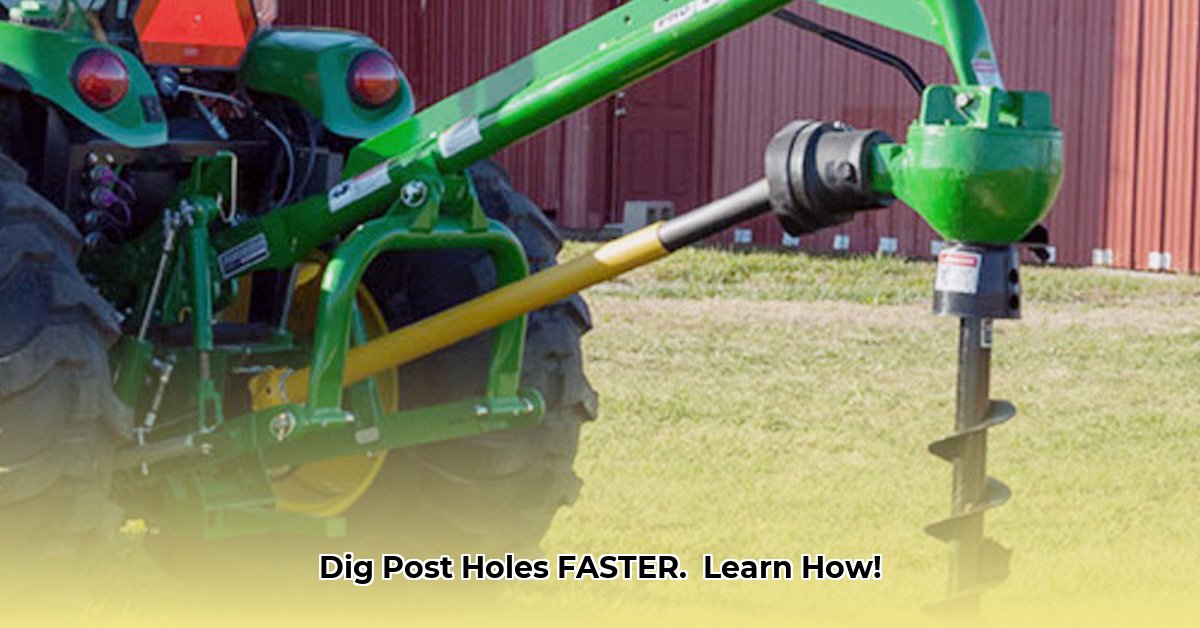
Ready to transform post hole digging from a back-breaking chore into a breeze? This comprehensive guide will equip you with the knowledge and skills to efficiently operate a tractor post digger, regardless of your experience level. We'll cover everything from pre-digging preparation to troubleshooting and maintenance, enhancing your productivity and minimizing effort. Let's dig in! For more detailed information on compact tractor post hole diggers, check out this helpful resource: Compact Tractor Diggers.
Getting Ready: Pre-Digging Prep Work
Before you even start the tractor, thorough preparation is key. Think of this as the equivalent of prepping your ingredients before cooking – a little upfront time saves frustration later.
First, inspect your auger (the drilling bit) for any damage. Dull cutting edges significantly reduce efficiency. Sharpen them if needed. Then, ensure the post hole digger is securely attached to your tractor's three-point hitch. Consult your owner's manual for specific instructions on your machine's connection procedure. Finally, clear your work area of rocks, debris, and other obstacles that could damage the equipment or cause injury. This proactive approach ensures optimal performance and safety. Did you know that a sharp auger can increase digging speed by up to 25%?
Mounting the Post Hole Digger: Attaching the Auger
Now let's attach the post hole digger to your tractor. This is typically a straightforward process, but following these steps will ensure correctness and safe operation:
Engage the Hitch: Activate your tractor's three-point hitch system (the mechanism that lifts and lowers implements).
Align and Connect: Carefully align the post hole digger's mounting pins with the corresponding holes on your tractor's hitch. Precision is critical here.
Secure the Connection: Insert the pins and ensure they are securely fastened. A firm connection prevents detachment during operation.
Adjust the Depth: Use the depth control mechanism (specific to your model) to set the desired post hole depth. Consistent depth ensures uniform post setting.
Operating Your Tractor Post Digger: Digging Those Holes!
With the auger mounted, it's time to dig! Lower the auger into the ground slowly, gradually increasing the tractor's speed as the auger begins to penetrate the soil. Avoid excessive speed, which can damage the auger or create uneven holes. Finding the right balance will optimize your digging efficiency.
“Remember to adjust your speed based on the soil type,” advises Dr. Emily Carter, Agricultural Engineering Professor at Purdue University. “Clay and rocky soil often require a slower, more controlled approach.” Different soil conditions demand varied operating techniques. Always maintain situational awareness and prioritize safety. What is the average digging speed for a tractor post digger in loose soil versus clay soil? The difference can be substantial.
Maintenance and Troubleshooting: Keeping Your Digger Happy
Regular maintenance prevents costly repairs and prolongs the life of your post hole digger. After each use, thoroughly clean the auger, removing all soil and debris. Lubricate moving parts according to the manufacturer's recommendations. Inspect the auger for any signs of wear or damage.
“A well-maintained auger not only digs faster but reduces the risk of costly repairs,” states John Miller, Lead Mechanic at John Deere Implement. If you encounter problems, consult your owner's manual, which offers detailed troubleshooting guidance. For persistent issues, consider professional assistance. What is the approximate lifetime of a well-maintained tractor post hole digger?
Safety First: Protecting Yourself and Your Equipment
Safety should always be your top priority when operating any machinery. Observe these crucial safety precautions:
- Gear Up: Always wear safety glasses, sturdy gloves, and strong work boots.
- Secure Equipment: Ensure the auger and mounting system are securely fastened before operation.
- Situational Awareness: Maintain constant awareness of your surroundings, particularly when working on slopes or near obstacles.
- Operate Responsibly: Never operate the machine when fatigued or under the influence of alcohol or drugs.
- Consult the Manual: Refer to your owner's manual for detailed safety guidelines.
Weighing the Pros and Cons: Is a Tractor Post Digger Right for You?
Before investing, it’s helpful to weigh the benefits against potential drawbacks:
| Advantages | Disadvantages |
|---|---|
| Significantly faster than manual digging | Requires a tractor and specialized equipment |
| Digs deeper and more uniform holes | Higher initial cost than manual methods |
| Less physically demanding | Can be challenging in extremely hard soil conditions |
| Improved efficiency | Requires regular maintenance and potential repairs |
Remember, consistent practice enhances your skills. With preparation, proper operation, and diligent maintenance, you'll soon become a post hole digging expert. Happy digging!